|
Russian Railroads
Authors: Helmut Ohley & Leonhard Orgler
Publisher: Hans im Glück
Year: 2013
review by

| x |
|
|
|
|
|
|
|
|
|
|
|
|
|
|
|
|
|
|
|
|
|
|
|
|
|
|
|
|
|
|
|
|
|
|
|
|
|
|
|
|
|
|
|
|
|
|
|
|
|
|
|
|
|
|
|
|
|
|
|
|
|
|
 |
Russia, the late 19th century. The industrialisation is unstoppable! If Russia wants to be taken seriously, they'll have to invest in an impressive railway network. The Trans Siberian Express between Moscow and Vladivostok is the most famous track, but while we’re at it, Moscow will also be connected to Saint Petersburg and Kiev. And we try to accomplish all this in a mere seven rounds!
|
|
|
| x |
|
|
|
|
|
|
|
|
|
|
|
|
|
|
|
|
|
|
|
|
|
|
|
|
|
|
|
|
|
|
|
|
|
|
|
|
|
|
|
|
|
|
|
|
|
|
|
|
|
|
|
|
|
|
|
|
|
|
|
|
|
|
|
The players each receive their own player board depicting the three railway tracks, and an industry track. The central board shows all the actions the players can perform by placing one of their five workers. Each action takes 1, 2 or 3 workers. When an action has been performed, it’s no longer available for other players. Players can always use a coin instead of a worker, enabling them to perform more actions than their five workers allow.
|
|
|
| x |
|
|
|
|
|
|
|
|
|
|
|
|
|
|
|
|
|
|
|
|
|
|
|
|
|
|
|
|
|
|
|
|
|
|
|
|
|
|
|
|
|
|
|
|
|
|
|
|
|
|
|
|
|
|
|
|
|
|
|
|
|
|
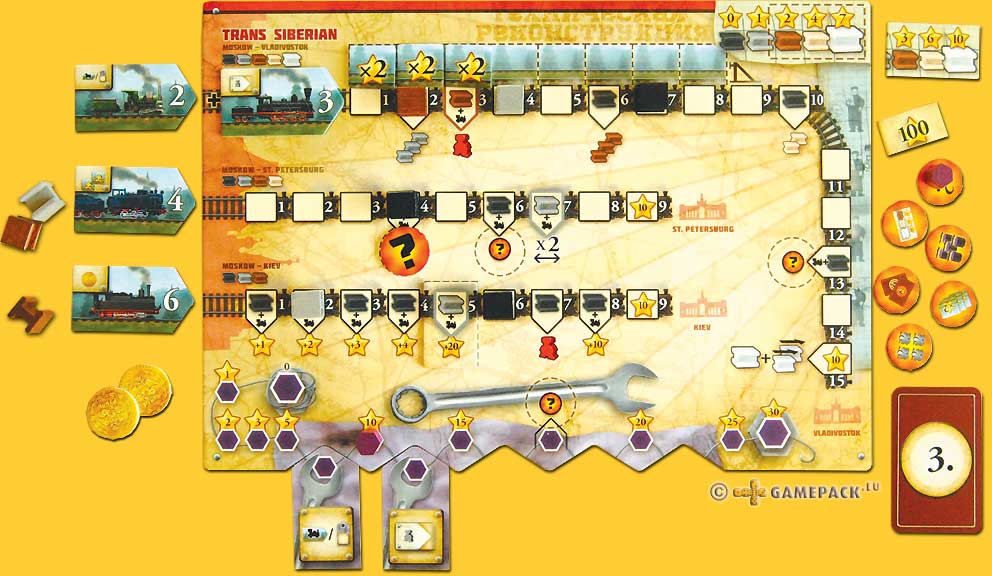 |
| xx |
|
|
|
|
|
|
|
|
|
|
|
|
|
|
|
|
|
|
|
|
|
|
|
|
|
|
|
|
|
|
|
|
|
|
|
|
|
|
|
|
|
|
|
|
|
|
|
|
|
|
|
|
|
|
|
|
|
|
|
|
|
|
| Most actions involve building rails: players place rails in different colours on each of their three tracks. Each colour represents a different quality of rails, and the higher the quality, the more points they score each round. Players start with black rails, the lowest quality, on each of their three tracks. The other colours have to be earned before they can be used. The rails always have to be built in consecutive order from low to high quality, it is not permitted to skip a level, and the rails can never ‘overtake’ each other. When laying black rails, the black rails token is moved forward along the track. All the fields behind the black token count as ‘black’. If, later in the game, another colour rails is introduced, the corresponding token follows the black token, without ever overtaking it. |
|
|
| x |
|
|
|
|
|
|
|
|
|
|
|
|
|
|
|
|
|
|
|
|
|
|
|
|
|
|
|
|
|
|
|
|
|
|
|
|
|
|
|
|
|
|
|
|
|
|
|
|
|
|
|
|
|
|
|
|
|
|
|
|
|
|
 |
|
|
| x |
|
|
|
|
|
|
|
|
|
|
|
|
|
|
|
|
|
|
|
|
|
|
|
|
|
|
|
|
|
|
|
|
|
|
|
|
|
|
|
|
|
|
|
|
|
|
|
|
|
|
|
|
|
|
|
|
|
|
|
|
|
|
| This implies that, in order to build the 5th colour, which is the highest quality of rails, the black token has to be moved forward at least four spaces, otherwise there is not enough room for the other four colours! At the end of each round, the players receive 0, 1, 2, 4 or 7 points for each space containing black, grey, brown, ivory or white rails, respectively. But!! Players only score points for the spaces their locomotives can reach. Each of the three tracks contains one locomotive, and Trans Siberian Express even two. Everyone starts with one 1-locomotive that can only reach the first space of the track. Fortunately, acquiring a new locomotive is one of the possible actions in the game. |
|
|
| x |
|
|
|
|
|
|
|
|
|
|
|
|
|
|
|
|
|
|
|
|
|
|
|
|
|
|
|
|
|
|
|
|
|
|
|
|
|
|
|
|
|
|
|
|
|
|
|
|
|
|
|
|
|
|
|
|
|
|
|
|
|
|
 |
|
|
| x |
|
|
|
|
|
|
|
|
|
|
|
|
|
|
|
|
|
|
|
|
|
|
|
|
|
|
|
|
|
|
|
|
|
|
|
|
|
|
|
|
|
|
|
|
|
|
|
|
|
|
|
|
|
|
|
|
|
|
|
|
|
|
|
Just scoring points is not the only reason to build rails! Along the tracks, several bonuses can be earned, some of which are simply indispensable. The grey, brown, ivory and white rails, for instance, can only be used after a player has reached the second, sixth, tenth or 15th space of the Trans Siberian track with its black rails token! In this case it is not important whether or not the locomotive is strong enough to reach these fields. Sometimes this is a requirement: on the Moscow – Saint Petersburg track, a player may use one of his bonus chits as soon as his black rails AND his locomotive have reached the fourth and sixth space.
|
|
|
| x |
|
|
|
|
|
|
|
|
|
|
|
|
|
|
|
|
|
|
|
|
|
|
|
|
|
|
|
|
|
|
|
|
|
|
|
|
|
|
|
|
|
|
|
|
|
|
|
|
|
|
|
|
|
|
|
|
|
|
|
|
|
|
 |
Each player has seven bonus chits, and he can use only four of them at maximum, if he manages to fulfil the requirements. These bonus chits are all very strong, so it’s often difficult to choose! Worth mentioning is the chit that allows the player to select a card that yields points at game end, provided that certain requirements have been met. These cards are kept secret until the end of the game.
|
|
|
|
|
|
|
|
|
|
|
|
|
|
|
|
|
|
|
|
|
|
|
|
|
|
|
|
|
|
|
|
|
|
|
|
|
|
|
|
|
|
|
|
|
|
|
|
|
|
|
 |
| x |
|
|
|
|
|
|
|
|
|
|
|
|
|
|
|
|
|
|
|
|
|
|
|
|
|
|
|
|
|
|
|
|
|
|
|
|
|
|
|
|
|
|
|
|
|
|
|
|
|
|
|
|
|
|
|
|
|
|
|
|
|
|
|
The industry track is an alternative means to score points, especially for those who are not really into trains. There are several actions on the board allowing a player to move his industry marker forward. There are gaps in the track, and the marker can only pass the gap once it has been filled with a factory.
|
|
|
| x |
|
|
|
|
|
|
|
|
|
|
|
|
|
|
|
|
|
|
|
|
|
|
|
|
|
|
|
|
|
|
|
|
|
|
|
|
|
|
|
|
|
|
|
|
|
|
|
|
|
|
|
|
|
|
|
|
|
|
|
|
|
|
|
A factory is a locomotive positioned upside down; it can be obtained using the same action used to acquire a locomotive. The different factories (id est, the back side of the different values of locomotives) also depict a bonus action that can be carried out as soon as the industry marker reaches this factory. The industry track scores up to 30 points per round, and it is also possible to obtain a second industry marker and follow the entire track a second time. This means: carrying out the factory bonus actions a second time, and scoring double victory points!
|
|
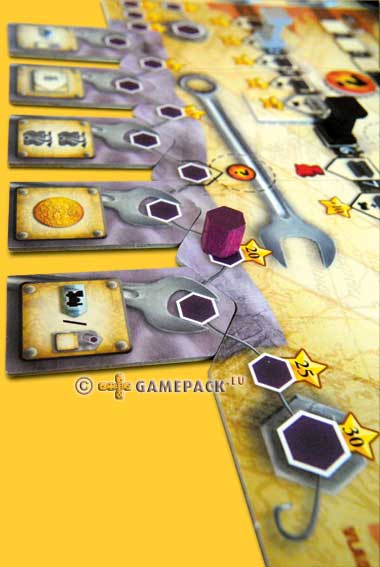 |
|
|
| x |
|
|
|
|
|
|
|
|
|
|
|
|
|
|
|
|
|
|
|
|
|
|
|
|
|
|
|
|
|
|
|
|
|
|
|
|
|
|
|
|
|
|
|
|
|
|
|
|
|
|
|
|
|
|
|
|
|
|
|
|
|
|
|
We are aided in our challenges by a team of engineers. Each engineer depicts one action, and each round one engineer is available as an additional action on the board. The next round this engineer is moved to the next field, where it can be purchased for one coin instead of used. The buyer places the engineer next to his player board: from now on, he has an additional action to his availability that only he can use! Additionally, the player with the most engineers is rewarded a nice sum of victory points at the end of the game.
|
|
|
| x |
|
|
|
|
|
|
|
|
|
|
|
|
|
|
|
|
|
|
|
|
|
|
|
|
|
|
|
|
|
|
|
|
|
|
|
|
|
|
|
|
|
|
|
|
|
|
|
|
|
|
|
|
|
|
|
|
|
|
|
|
|
|
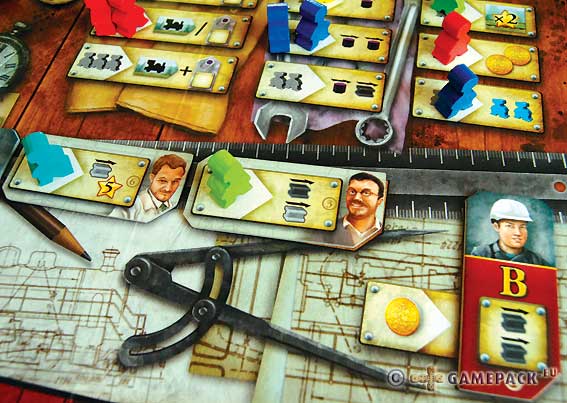 |
|
|
| x |
|
|
|
|
|
|
|
|
|
|
|
|
|
|
|
|
|
|
|
|
|
|
|
|
|
|
|
|
|
|
|
|
|
|
|
|
|
|
|
|
|
|
|
|
|
|
|
|
|
|
|
|
|
|
|
|
|
|
|
|
|
|
| After the seventh scoring round, the game end bonus cards are revealed and scored, and the 40 pints for the player with the most engineers are awarded. The player with the highest score wins the game! |
|
|
| x |
|
|
|
|
|
|
|
|
|
|
|
|
|
|
|
|
|
|
|
|
|
|
|
|
|
|
|
|
|
|
|
|
|
|
|
|
|
|
|
|
|
|
|
|
|
|
|
|
|
|
|
|
|
|
|
|
|
|
|
|
|
|
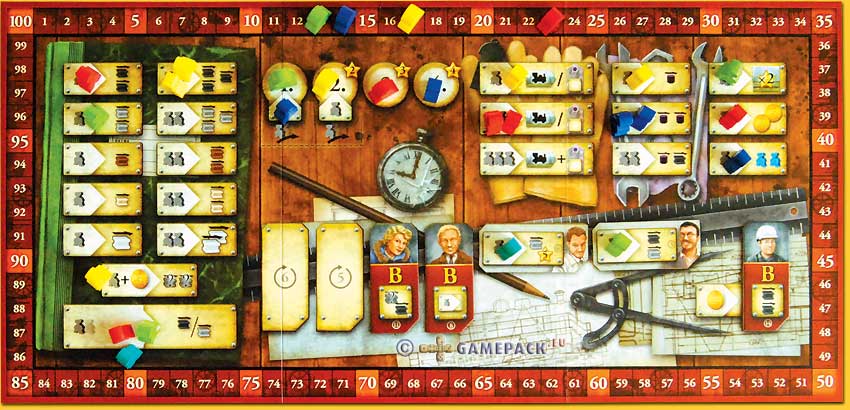 |
| x |
| x |
| x |
 |
|
|
|
|
|
|
|
|
|
|
|
|
|
|
|
|
|
|
|
|
|
|
|
|
|
|
|
|
|
|
|
|
|
|
|
|
|
|
|
|
|
|
|
|
|
|
|
|
|
|
|
|
|
|
No beating around the bush: Russian Railroads is an outstanding game! Exciting, challenging, unbelievably well-balanced, versatile and atmospheric. There are four tracks: three railway tracks and the industry track. Since it is impossible to develop each of them equally well in a mere seven rounds, the players have to make choices. The good news is that all strategies can be winning. Developing the long Trans Siberian track to the end, so that the white rails come into play which can score up to 20 (!) points per space per round.
|
|
|
| x |
|
|
|
|
|
|
|
|
|
|
|
|
|
|
|
|
|
|
|
|
|
|
|
|
|
|
|
|
|
|
|
|
|
|
|
|
|
|
|
|
|
|
|
|
|
|
|
|
|
|
|
|
|
|
|
|
|
|
|
|
|
|
 |
| x |
|
|
|
|
|
|
|
|
|
|
|
|
|
|
|
|
|
|
|
|
|
|
|
|
|
|
|
|
|
|
|
|
|
|
|
|
|
|
|
|
|
|
|
|
|
|
|
|
|
|
|
|
|
|
|
|
|
|
|
|
|
|
|
Or the Saint Petersburg track, that enables the player to use two bonus chits, and which doubles the score for the entire track once the 7th space has been reached by the grey rails. Or the Kiev track, that can already give rise to up to 40 points per scoring round even when only black and grey rails have been built. Or the industry track, with all the useful bonus actions depicted on the factories, and up to 55 points per scoring round if both industry markers have reached the end of the track.
|
|
|
| x |
|
|
|
|
|
|
|
|
|
|
|
|
|
|
|
|
|
|
|
|
|
|
|
|
|
|
|
|
|
|
|
|
|
|
|
|
|
|
|
|
|
|
|
|
|
|
|
|
|
|
|
|
|
|
|
|
|
|
|
|
|
|
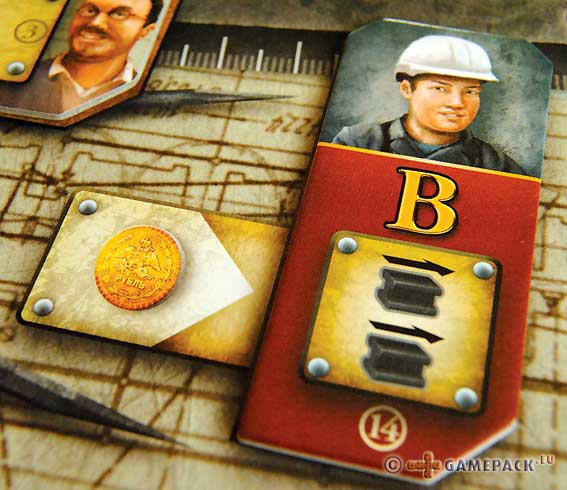 |
|
|
| x |
|
|
|
|
|
|
|
|
|
|
|
|
|
|
|
|
|
|
|
|
|
|
|
|
|
|
|
|
|
|
|
|
|
|
|
|
|
|
|
|
|
|
|
|
|
|
|
|
|
|
|
|
|
|
|
|
|
|
|
|
|
|
|
It is commendable to use a tactic that is not already employed by all the competitors: if everybody goes for the Trans Siberian and not for the industry track, the actions required to lay rails will be very popular, while the actions to move an industry marker will be readily available. It is also convenient to buy engineers: with your own engineer actions you rely less on the availability of the actions on the main player board.
|
|
|
| x |
|
|
|
|
|
|
|
|
|
|
|
|
|
|
|
|
|
|
|
|
|
|
|
|
|
|
|
|
|
|
|
|
|
|
|
|
|
|
|
|
|
|
|
|
|
|
|
|
|
|
|
|
|
|
|
|
|
|
|
|
|
|
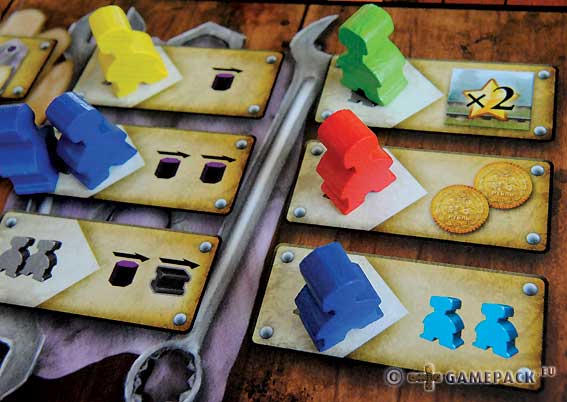 |
|
|
| x |
|
|
|
|
|
|
|
|
|
|
|
|
|
|
|
|
|
|
|
|
|
|
|
|
|
|
|
|
|
|
|
|
|
|
|
|
|
|
|
|
|
|
|
|
|
|
|
|
|
|
|
|
|
|
|
|
|
|
|
|
|
|
| The game is well-designed, the icons are clear, as are the rules. The only criticism concerns the box: it looks rather aggressive with the huge red locomotive, enveloped in a cloud of dust, appearing to leave the drawing on a certain collision course with the observer. The angular black-and-red text further strengthens this impression. It suggests that damage will be done. War! To arms! A game for rugged men, not for peaceful families! But open the box, and a completely different image appears. Friendly, with stars, trains, meeples and sympathetic-looking engineers. The contrast could hardly have been bigger. |
|
|
| x |
|
|
|
|
|
|
|
|
|
|
|
|
|
|
|
|
|
|
|
|
|
|
|
|
|
|
|
|
|
|
|
|
|
|
|
|
|
|
|
|
|
|
|
|
|
|
|
|
|
|
|
|
|
|
|
|
|
|
|
|
|
|
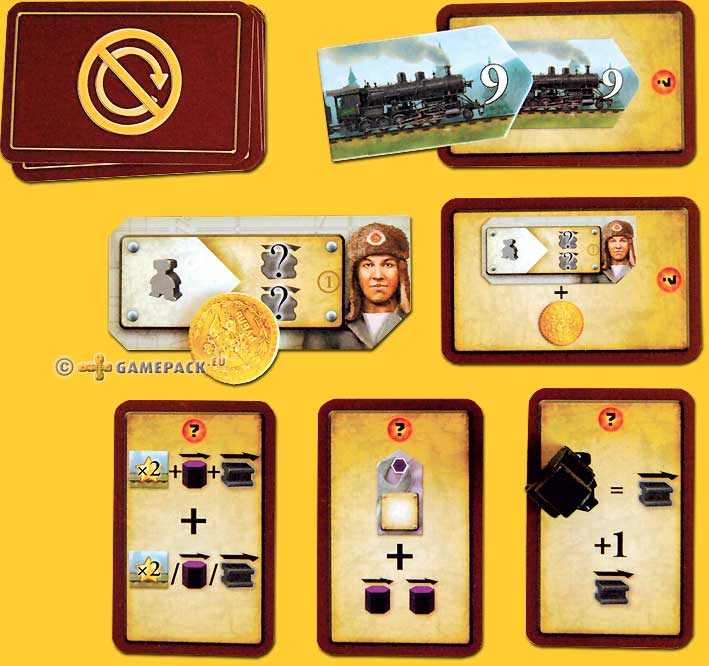 |
|
|
| x |
|
|
|
|
|
|
|
|
|
|
|
|
|
|
|
|
|
|
|
|
|
|
|
|
|
|
|
|
|
|
|
|
|
|
|
|
|
|
|
|
|
|
|
|
|
|
|
|
|
|
|
|
|
|
|
|
|
|
|
|
|
|
This is a pity: the experienced player will see through this discrepancy, but grandma and grandpa will probably move on to the next isle in the toy store… And that while Russian Railroads is well suited for inexperienced players! The game is of course as deep as its players, but the rules are easy to comprehend and quick to explain. Russian Railroads is a game you want to play over and over again. Preferably whilst using a new strategy every time!
© 2014 Barbara van Vugt
Russian Railroads, Helmut Ohley & Leonhard Orgler, Hans im Glück, 2013 - 2 to 4 players, 12 years and up, 120 minutes
|
|
|
  |
|
|
|
|
|
|
|
|
|
|
|
|
|
|
|
|
|
|
|
|
|
|
|
|
|
|
|
|
|
|
|
|
|
|
|
|
|
|
|
|
|
|
|
|
|
|
|
|
|
|
|
|
|
  |
|
|
|
|
|
|
|
|
|
|
|
|
|
|
|
|
|
|
|
|
|
|
|
|
|
|
|
|
|
|
|
|
|
|
|
|
|
|
|
|
|
|
|
|
|
|
|
|
|
|
|
|
|
  |
|
|
|
|
|
|
|
|
|
|
|
|
|
|
|
|
|
|
|
|
|
|
|
|
|
|
|
|
|
|
|
|
|
|
|
|
|
|
|
|
|
|
|
|
|
|
|
|
|
|
|
|
|
  |
|
|
|
|
|
|
|
|
|
|
|
|
|
|
|
|
|
|
|
|
|
|
|
|
|
|
|
|
|
|
|
|
|
|
|
|
|
|
|
|
|
|
|
|
|
|
|
|
|
|
|
|
|
  |
|
|
|
|
|
|
|
|
|
|
|
|
|
|
|
|
|
|
|
|
|
|
|
|
|
|
|
|
|
|
|
|
|
|
|
|
|
|
|
|
|
|
|
|
|
|
|
|
|
|
|
|
|
  |
|
My fear is that Russian Railroads is like a fireworks that flies rapidly to a very high altitude and bursts with all sorts of nice colours, but after that has not more to offer. Are the -limited- strategies enough to keep one fascinated? Will it stay a highflyer, or will the shine in the game be gone after a while? After some ten games of RRR there is at least a start of a routine action to be perceived.
Russian Railroads is a game that can be explained very easily, even to inexperienced players. The offered intermission in the -bulky and complete- rules reflect the atmosphere well and comes down to: 'Easy, it's not hard at all'. And it isn't indeed.
Russian Railroads seems atypical for Hans im Glück, compared to direct predecessors such as Stone Age or Pantheon. But HiG also has published games such as Amun Re and Tigris & Euphrates, so as strange as it seems at first it isn't at all in the end. |
|
|
| x |
|
|
|
|
|
|
|
|
|
|
|
|
|
|
|
|
|
|
|
|
|
|
|
|
|
|
|
|
|
|
|
|
|
|
|
|
|
|
|
|
|
|
|
|
|
|
|
|
|
|
|
|
|
|
|
|
|
|
|
|
|
|
| x |
|
|
|
|
|
|
|
|
|
|
|
|
|
|
|
|
|
|
|
|
|
|
|
|
|
|
|
|
|
|
|
|
|
|
|
|
|
|
|
|
|
|
|
|
|
|
|
|
|
|
|
|
|
|
|
|
|
|
|
|
|
|
 |
|
|
|
|
|
|
|
|
|
|
|
|
|
|
|
|
|
|
|
|
|
|
|
|
|
|
|
|
|
|
|
|
|
|
|
|
|
|
|
|
|
|
|
|
|
|
|
|
|
|
|
|
|
 |
|
|
|
|
|
|
|
|
|
|
|
|
|
|
|
|
|
|
|
|
|
|
|
|
|
|
|
|
|
|
|
|
|
|
|
|
|
|
|
|
|
|
|
|
|
|
|
|
|
|
|
|
|
| x |
|
|
|
|
|
|
|
|
|
|
|
|
|
|
|
|
|
|
|
|
|
|
|
|
|
|
|
|
|
|
|
|
|
|
|
|
|
|
|
|
|
|
|
|
|
|
|
|
|
|
|
|
|
|
|
|
|
|
|
|
|
|
 |
|
|
|
|
|
|
|
|
|
|
|
|
|
|
|
|
|
|
|
|
|
|
|
|
|
|
|
|
|
|
|
|
|
|
|
|
|
|
|
|
|
|
|
 |
|
|
|
|
|
|
|
|
|
|
|
|
|
|
|
|
|
|
|
|
|
|
|
|
|
|
|
|
|
|
|
|
|
|
|
|
|
|
|
|
|
|
|
|
|
|
|
|
|
|
|
|
|
|
|
|
|
|
|
|
|
|
|
|
|
|
|
|
|
|
|
|
|
|
|
|
|
|
|
|
|
|
|
|
|
|
|
|
|